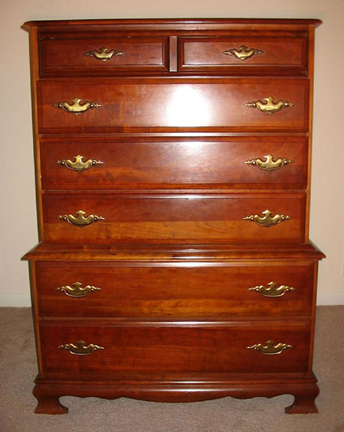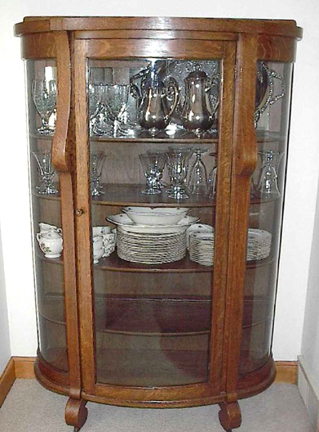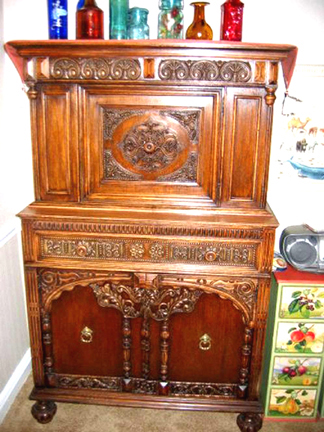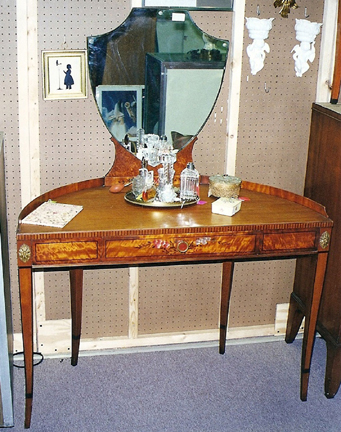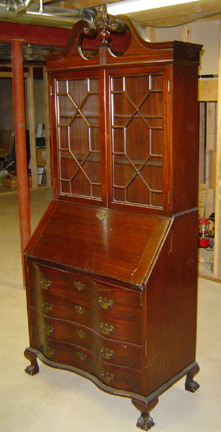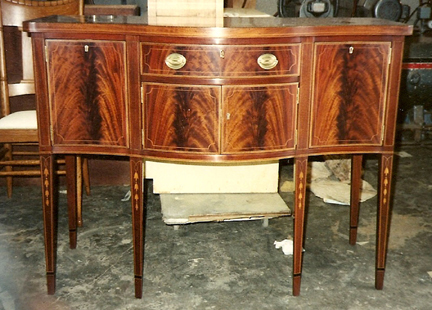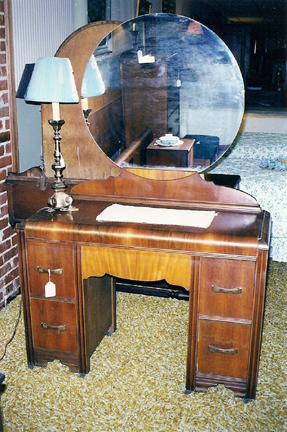
In the modern version of American English as spoken in this country today, there are occasions when it seems there are too many notes, or least too many names, used for the same, or substantially the same, piece of furniture. No wonder so many people find the subject of furniture to be dense and daunting. Following are a few examples of duplications, overlaps or just plain confusion in the terms we use to describe the functional art we call furniture. You decide if there are “too many notes” or just the right number.
Start with that head-high device in your bedroom that you use to store clothes. It is a series of receptacles stacked vertically that can be withdrawn from a rack or case of some sort to allow access to articles stored there. It’s a simple enough arrangement at first glance. What do you call it? You might call it, incorrectly, a dresser but that name actually belongs to another form. You might also call it a chest, which it certainly is. But there is an almost infinite variety of chests. Shouldn’t we be more specific? OK. How about chest of drawers? That works unless you are from a certain part of the country where it is called a “chester draws.”
That’s simple enough. What else could it be called? How about “chiffonier,” meaning “rag picker” in French. (Of course that opens up the derivatives of chiffonier like chifferobe and chifforette but that’s another story.) The word is used to describe a tall, narrow chest of drawers, but then so is “semainier,” another word used for a tall chest with six or seven drawers, one for the personal linens for each day of the week. Then there is a word often encountered in the Deep South used to describe a chest of drawers – “bureau.” Where did that come from? It also came from France in a very roundabout way.
When the concept of a permanent stationary writing surface appeared in Europe in the Middle Ages, the flat surface was often covered in thin layer of wool called by its French name, bure. Thus the desk became a “bureau.” Then drawers were added to the desk and a cabinet was the result. In the late 18th century Thomas Sheraton defined a bureau as a common desk with drawers and this became the standard English word for a desk with drawers. For some reason American colonists chose to use the term secretary for that arrangement and to the Americans a bureau became a name for the bedroom chest – back full circle to the chest of drawers.
So what happened to the “bureau” that became a secretary in the New World? And where did “secretary” come from? It came from the Latin terms scrutoire and scriptoire, which have to do with writing. In areas of Spanish influence it was known as the vargueno, a chest on a stand. In the American colonies it was a desk on frame or a desk box on a lowboy. As the form evolved it became known as a slant-front desk, a drop-front desk and a secretary desk. Eventually the term “secretary” was used in many quarters to denote the drop-front desk unit with a bookcase stacked on top. It was then called a “bookcase secretary” with its variation the side-by-side bookcase secretary. What it should never have been called is the “Governor Winthrop” even though that name has almost acquired a “common-law legitimacy through use” license.
The story goes that the first governor of the Massachusetts Bay Colony in the 17th century, John Winthrop, had a desk like this. Winthrop was born in England in 1588 and died in the colony in 1649. This was at least 50 years before the drop-front desk appeared in England and about 100 years before Thomas Chippendale gave it the famous form that commonly bears the governor’s name. In other words Gov. Winthrop did not have a desk like this. So who is responsible for the name given to the form of the drop-front desk? The Winthrop Furniture Co. of Boston has that honor. They introduced a new model of the desk in 1924 and called it the “Gov. Winthrop,” a clever play on words that has polluted the trade vocabulary for over 80 years.
In the second paragraph I mentioned that a chest is not a dresser. So what is a dresser? In normal terms we refer to a low chest with a mirror as a dresser, giving credit to its history as a dressing device. The dressing table, with or without a mirror, has been a part of our daily lives for several hundred years. Prior to the 19th century the mirror was a separate and portable accessory. Only in the early Federal period did precious mirror glass become attached to a cabinet and once the mirror became fixed the dressing table took on several other identities.
Of course the most obvious was the evolution from the table or stand with a mirror to the modern vanity, complete with multiple mirrors, drawers, shelves and matching seating arrangement. On the way, though, it acquired several other names like the more or less self-contained “poudreuse,” literally the “power table” used by French gentlemen in the early 19th century. And of course there was the English version named for bad boy Beau Brummel. But sometimes a vanity as we know it is still referred to as a dresser.
So much for personal grooming. How about some of the cabinetwork in the dining room? Well a chair is pretty much a chair and a table is pretty much a table, but we still have to store the china somewhere. The china storage cabinet is often called a “hutch” or a “china hutch.” The word is derived from the French word huche and refers to a cabinet with doors that stands on legs. But the form we commonly call a “china cabinet” doesn’t always have doors or legs so it isn’t really a hutch. Also called a hutch is a cabinet that has lower doors and upper open shelves but often has no legs. Still a hutch? Another variation is to call a china cabinet a cupboard, which it technically is since a cupboard is defined as a cabinet or box with doors. Pretty straightforward but not very informative.
In modern usage a china cabinet usually has glass doors to allow us to see the family treasure but one version does not. During the Great Depression a 17th-century version of the cabinet was revived for use in 20th-century dining rooms. It was a solid-looking affair with blind doors that concealed all china from sight. This type cabinet was used in European dining halls to store dishes and silver. It was originally called a court cupboard, but in the 1930s it became just another china cabinet.
So what do you want to call that long, low piece against the wall in the dining room? A sideboard? A buffet? A server? Side table? Dining room dresser?
Send your comments, questions and pictures to Fred Taylor at P.O Box 215, Crystal River, FL 34423 or info@furnituredetetcive.com. Visit Fred’s website at www.furnituredetective.com. His book How To Be a Furniture Detective is now available for $18.95 plus $3 shipping. Send check or money order for $21.95 to Fred Taylor, P.O. Box 215, Crystal River, FL 34423. Fred and Gail Taylor’s DVD, Identification of Older & Antique Furniture ($17 + $3 S&H) is also available at the same address. For more information call (800) 387-6377, fax 352-563-2916, or info@furnituredetective.com.
Fred Taylor is a freelance writer based in central Florida, who earned both a bachelor’s and master’s degree in finance from the University of Florida. While he is perhaps better known in his role as a nationally syndicated columnist on the subject of antique furniture, he is interested in almost all things related to Florida. He has covered many auctions both inside and outside the Sunshine State for leading antiques trade publications. Fred and his wife, Gail, love to travel Florida’s highways and byways on a Harley-Davidson motorcycle.
ADDITIONAL LOTS OF NOTE
